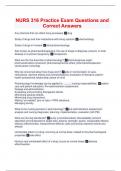NURS 316 Practice Exam Questions and
Correct Answers
Any chemical that can affect living processes ✅drug
Study of drugs and their interactions with living systems ✅pharmacology
Study of drugs in humans ✅clinical pharmacology
Also known as pharmacotherapeutics; the use of drugs to diagnose, prevent, or treat
disease or to prevent pregnancy ✅therapeutics
What are the five branches of pharmacology? ✅pharmacognosy-origin;
pharmacokinetics-movement; pharmacodynamics-effect; pharmacotherapeutics-
use/purpose; toxicology
Why be concerned about how drugs work? ✅aids in memorization of uses,
interactions, adverse effects and contraindications; evaluation of literature; patient-
health professional relationship; peace of mind
Pharmacologic knowledge can be applied to: _____; nursing responsibilities: ✅patient
care and patient education; Pre-administration assessment,
Dosage and administration,
Evaluating and promoting therapeutic effects,
Minimizing adverse effects,
Minimizing drug interactions,
Making "as needed" (pro re nata = PRN) decisions,
Managing toxicity
What is the nursing process in pharmacology? ✅pre-administration assessment,
analysis and nursing diagnoses, planning, implementation, evaluation (AD PIE)
What are the dug standards? ✅purity (uncontaminated); bioavailability (amount
absorbed and transported to target site); potency (strength, power, measurable effects);
efficacy (effectiveness, measurement difficult); safe and toxicity (adverse events and
effects)
Unintended effect of a drug; occurring at normal dose; related to the pharmacological
properties ✅side effect
Noxious and unintended effect of a drug; occurs at normal doses ✅adverse
effect/reaction
,Adverse reaction NOT consistent with applicable product information or characteristics
of drug ✅unintended adverse reaction
Medical occurrence; temporally associated with use of a medicinal product, but not
necessarily causally related, ex: drug interactions ✅adverse event
Any untoward medical occurrence that at any dose; results in death, is life threatening,
requires inpatient hospitalization or prolongation of hospital stay; results in persistence
of significant disability or incapacity ✅serious adverse event or reaction
Schedule of controlled substances ✅I: No accepted medical use/High potential abuse
Ex: Heroin, LSD, etc.
II: Severe Physical/Psychological Dependency
Ex: hydromorphone, oxycodone
III: Moderate/Low Physical or High Psychological Dependency
Ex: Anabolic steroids, codeine in combinations, etc.
IV: Limited Physical or Psychological Dependency
Ex: diazepam, lorazepam
V: Low Abuse Potential
Ex: Cough syrup w/codeine
Controlled drug regulations: RN implications: primarily schedule II substances; facility
specific; shift counts: beginning and end of each shift
2 licensed personnel manually count and compare quantity in dispensing system (Ex:
Pyxis®)
If counts are off... ✅Another nurse witness and then sign/document witness of
waste/discard
Nurse practice act ✅Each state has own regulations:
RN may not prescribe or administer Rx without MD order (or standing order [protocol]);
Advanced Practice Nurses may prescribe
(NP, CRNA, Certified Nurse Midwives, Clinical Nurse Specialists);
Controlled substances vary by state
Chemical Name
Generic Name
Derived from chemical name
Approved by FDA
WILL NOT change
Trade Name (Brand)
Selected by Manufacturer
Copyrighted - ®
May potentially change ✅
, How do drugs get into the body? ✅prescribed dose, administered dose (medication
errors, patient adherence); concentration of sites of action: pharmacokinetics
(absorption, distribution, metabolism, excretion); intensity of responses:
pharmacodynamics (drug-receptor interaction, patient's functional state, placebo
effects)
Movement from site of administration into the bloodstream
Unless injected directly into the blood stream, drugs must be absorbed.
Drug molecules travel across biological barriers (mostly layers of cells) ✅absorption
Rate of drug absorption are effected by: (5) ✅1. Pharmaceutical preparation
2. Membrane permeability of drug
3. Surface area in contact with drug
4. Blood flow to site of absorption
5. Destruction of drug at or near site of absorption
Pharmaceutical preparation-determinants of rate of release are ✅Dosage forms
Additives (Excipients)
Manufacturing parameters
Delayed-release preparations
Sustained-release preparations
Dosage forms: ✅solutions (no delay, immediate release); capsules and tablets (delay-
dissolution, followed by rapid release); creams, ointments, and suppositories (no delay,
slow release
Additives (excipients) ✅Decrease rate of dissolution
(Binders, lubricants, coating agents);
Increase rate of dissolution
(Disintegrants);
Variable effects on rate of dissolution
(Diluents, coloring agents, flavoring agents);
Protect active drug
Manufacturing parameters ✅Tablet compression
(Soft vs hard compression);
Tablet shape (Round vs square, etc.); Tablet size (Small vs large)
Example: Oral Medications (p.o.)
Pills must dissolve/breakdown
Most absorbed in small Intestine
Syrups/Suspensions more rapid onset
Delayed-release preparations ✅Enteric-coating (EC):
Resistant to gastric fluid,
Coating dissolves in intestines, not stomach,




